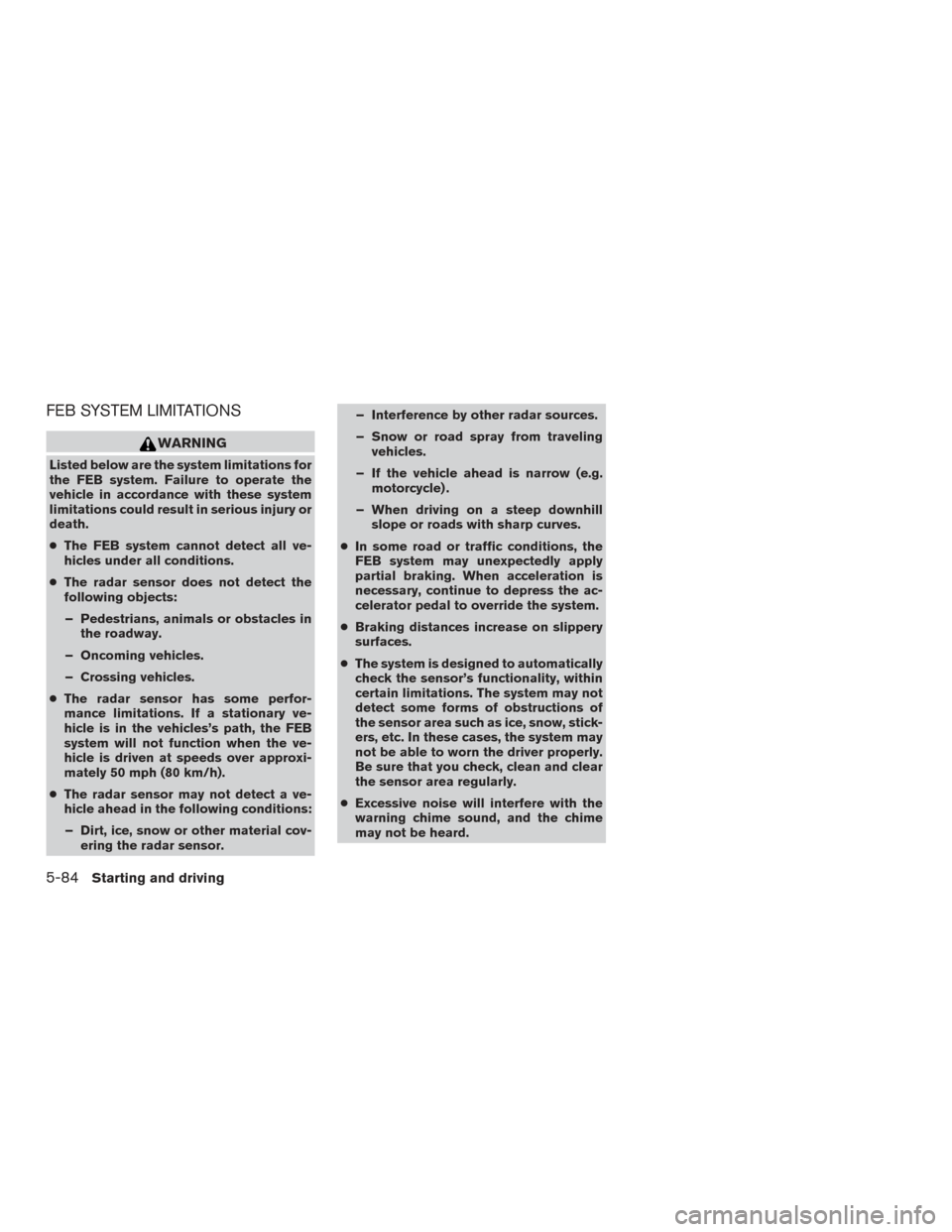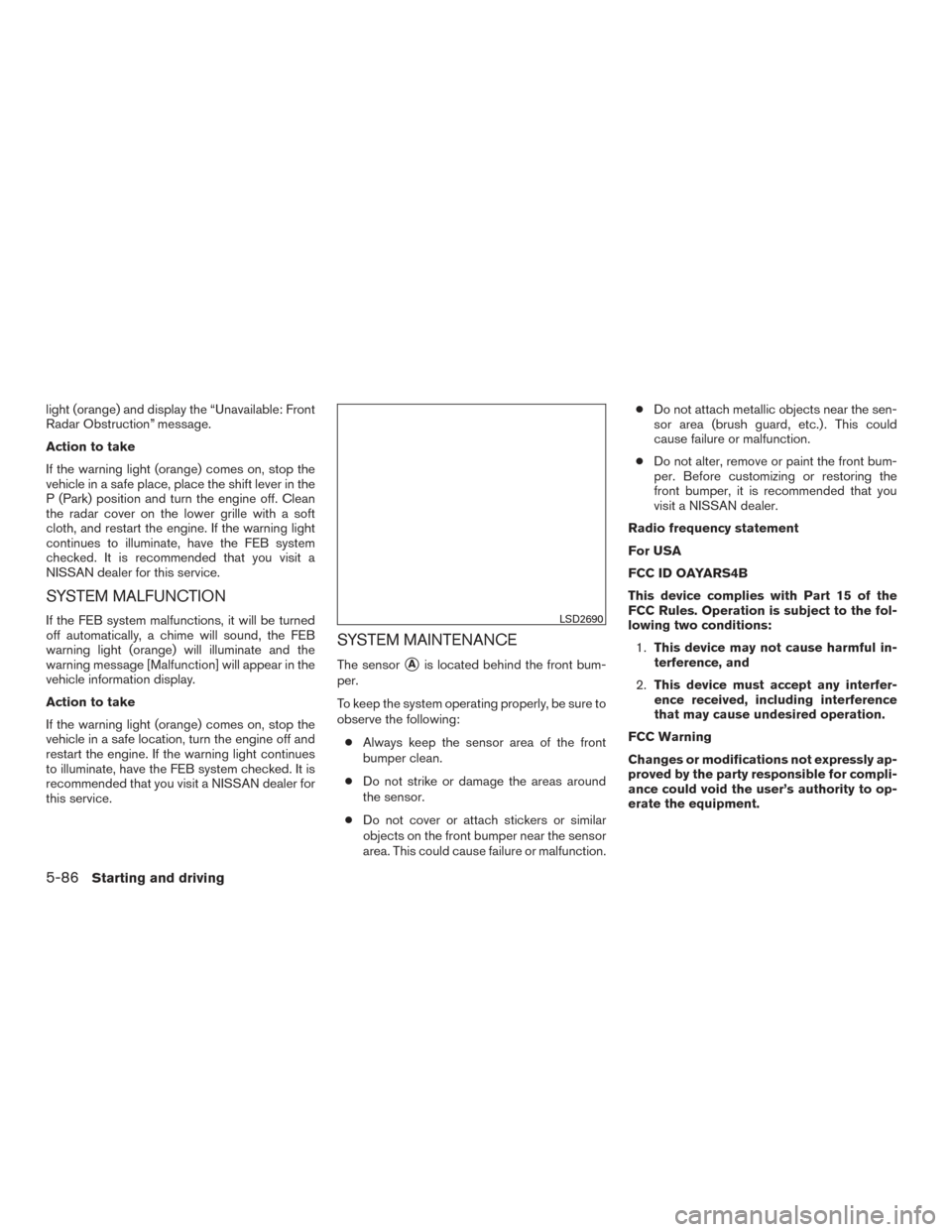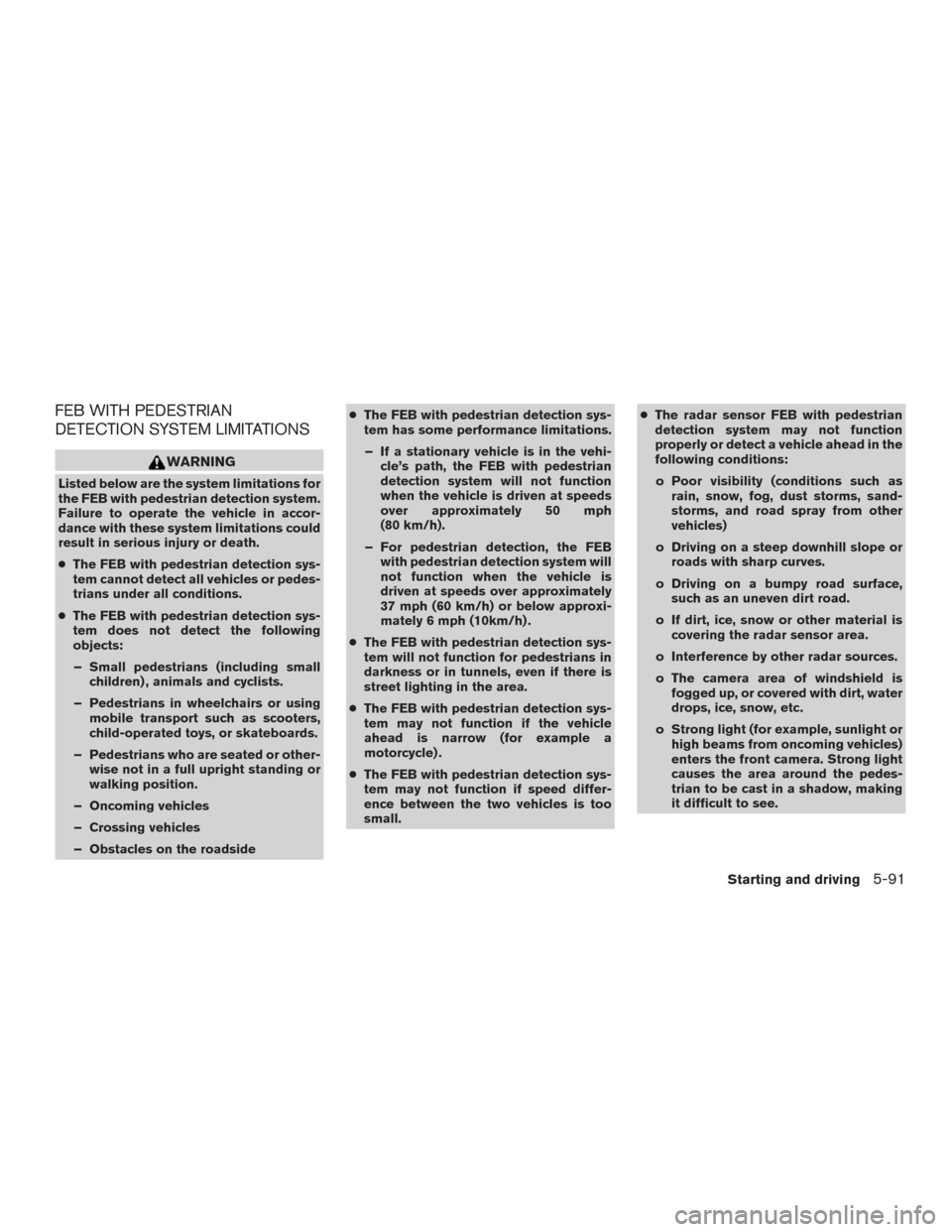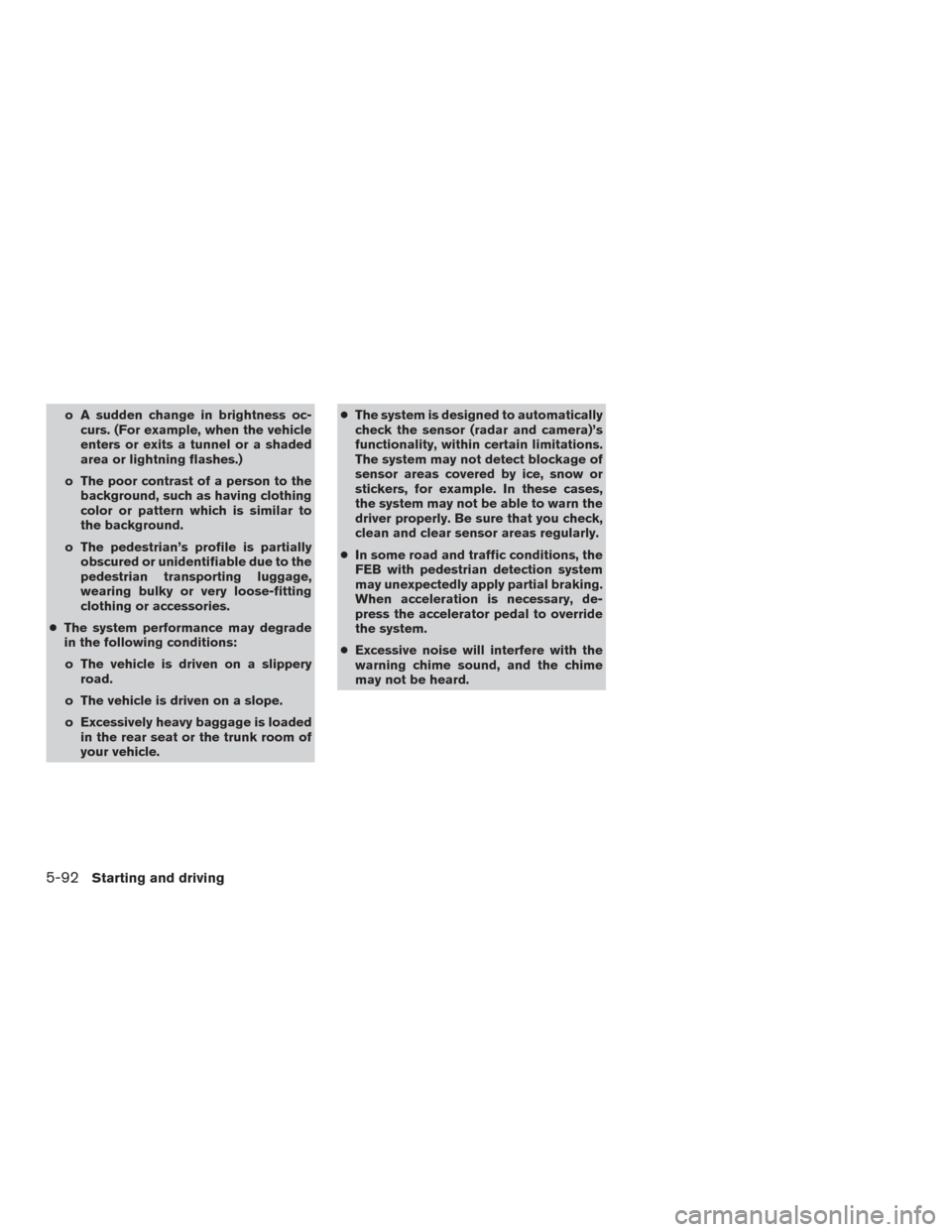Page 392 of 547
The FEB system uses a radar sensor�Alocated
behind the front bumper to measure the distance
to the vehicle ahead in the same lane.
LSD2690
LSD2687
Starting and driving5-81
Page 395 of 547

FEB SYSTEM LIMITATIONS
WARNING
Listed below are the system limitations for
the FEB system. Failure to operate the
vehicle in accordance with these system
limitations could result in serious injury or
death.
●The FEB system cannot detect all ve-
hicles under all conditions.
● The radar sensor does not detect the
following objects:
– Pedestrians, animals or obstacles in the roadway.
– Oncoming vehicles.
– Crossing vehicles.
● The radar sensor has some perfor-
mance limitations. If a stationary ve-
hicle is in the vehicles’s path, the FEB
system will not function when the ve-
hicle is driven at speeds over approxi-
mately 50 mph (80 km/h).
● The radar sensor may not detect a ve-
hicle ahead in the following conditions:
– Dirt, ice, snow or other material cov- ering the radar sensor. – Interference by other radar sources.
– Snow or road spray from traveling
vehicles.
– If the vehicle ahead is narrow (e.g. motorcycle) .
– When driving on a steep downhill slope or roads with sharp curves.
● In some road or traffic conditions, the
FEB system may unexpectedly apply
partial braking. When acceleration is
necessary, continue to depress the ac-
celerator pedal to override the system.
● Braking distances increase on slippery
surfaces.
● The system is designed to automatically
check the sensor’s functionality, within
certain limitations. The system may not
detect some forms of obstructions of
the sensor area such as ice, snow, stick-
ers, etc. In these cases, the system may
not be able to worn the driver properly.
Be sure that you check, clean and clear
the sensor area regularly.
● Excessive noise will interfere with the
warning chime sound, and the chime
may not be heard.
5-84Starting and driving
Page 396 of 547
SYSTEM TEMPORARILY
UNAVAILABLE
Condition A
When the radar sensor picks up interference
from another radar source, making it impossible
to detect a vehicle ahead, the FEB system is
automatically turned off.
The FEB system warning light (orange) will illu-
minate.
Action to take
When the above conditions no longer exist, the
FEB system will resume automatically.
Condition B
When the sensor area of the front bumper is
covered with dirt or is obstructed, making it im-
possible to detect a vehicle ahead, the FEB sys-
tem is automatically turned off.
The FEB system warning light (orange) will illu-
minate and the “Unavailable: Front Radar Ob-
struction” warning message will appear in the
vehicle information display.
When driving on roads with limited road struc-
tures or buildings (for example, long bridges,
deserts, snow fields, driving next to long walls) ,
the system may illuminate the system warning
LSD2717
Starting and driving5-85
Page 397 of 547

light (orange) and display the “Unavailable: Front
Radar Obstruction” message.
Action to take
If the warning light (orange) comes on, stop the
vehicle in a safe place, place the shift lever in the
P (Park) position and turn the engine off. Clean
the radar cover on the lower grille with a soft
cloth, and restart the engine. If the warning light
continues to illuminate, have the FEB system
checked. It is recommended that you visit a
NISSAN dealer for this service.
SYSTEM MALFUNCTION
If the FEB system malfunctions, it will be turned
off automatically, a chime will sound, the FEB
warning light (orange) will illuminate and the
warning message [Malfunction] will appear in the
vehicle information display.
Action to take
If the warning light (orange) comes on, stop the
vehicle in a safe location, turn the engine off and
restart the engine. If the warning light continues
to illuminate, have the FEB system checked. It is
recommended that you visit a NISSAN dealer for
this service.
SYSTEM MAINTENANCE
The sensor�Ais located behind the front bum-
per.
To keep the system operating properly, be sure to
observe the following:
● Always keep the sensor area of the front
bumper clean.
● Do not strike or damage the areas around
the sensor.
● Do not cover or attach stickers or similar
objects on the front bumper near the sensor
area. This could cause failure or malfunction. ●
Do not attach metallic objects near the sen-
sor area (brush guard, etc.) . This could
cause failure or malfunction.
● Do not alter, remove or paint the front bum-
per. Before customizing or restoring the
front bumper, it is recommended that you
visit a NISSAN dealer.
Radio frequency statement
For USA
FCC ID OAYARS4B
This device complies with Part 15 of the
FCC Rules. Operation is subject to the fol-
lowing two conditions: 1. This device may not cause harmful in-
terference, and
2. This device must accept any interfer-
ence received, including interference
that may cause undesired operation.
FCC Warning
Changes or modifications not expressly ap-
proved by the party responsible for compli-
ance could void the user’s authority to op-
erate the equipment.
LSD2690
5-86Starting and driving
Page 399 of 547
The FEB with pedestrian detection system uses a
radar sensor located behind the lower grille of the
front bumper
�Ato measure the distance to the
vehicle ahead in the same lane. For pedestrians,
the FEB system uses a camera installed behind
the windshield in addition to the radar sensor.
LSD2711
LSD2687
5-88Starting and driving
Page 402 of 547

FEB WITH PEDESTRIAN
DETECTION SYSTEM LIMITATIONS
WARNING
Listed below are the system limitations for
the FEB with pedestrian detection system.
Failure to operate the vehicle in accor-
dance with these system limitations could
result in serious injury or death.
●The FEB with pedestrian detection sys-
tem cannot detect all vehicles or pedes-
trians under all conditions.
● The FEB with pedestrian detection sys-
tem does not detect the following
objects:
– Small pedestrians (including small children) , animals and cyclists.
– Pedestrians in wheelchairs or using mobile transport such as scooters,
child-operated toys, or skateboards.
– Pedestrians who are seated or other- wise not in a full upright standing or
walking position.
– Oncoming vehicles
– Crossing vehicles
– Obstacles on the roadside ●
The FEB with pedestrian detection sys-
tem has some performance limitations.
– If a stationary vehicle is in the vehi- cle’s path, the FEB with pedestrian
detection system will not function
when the vehicle is driven at speeds
over approximately 50 mph
(80 km/h).
– For pedestrian detection, the FEB with pedestrian detection system will
not function when the vehicle is
driven at speeds over approximately
37 mph (60 km/h) or below approxi-
mately 6 mph (10km/h) .
● The FEB with pedestrian detection sys-
tem will not function for pedestrians in
darkness or in tunnels, even if there is
street lighting in the area.
● The FEB with pedestrian detection sys-
tem may not function if the vehicle
ahead is narrow (for example a
motorcycle) .
● The FEB with pedestrian detection sys-
tem may not function if speed differ-
ence between the two vehicles is too
small. ●
The radar sensor FEB with pedestrian
detection system may not function
properly or detect a vehicle ahead in the
following conditions:
o Poor visibility (conditions such as rain, snow, fog, dust storms, sand-
storms, and road spray from other
vehicles)
o Driving on a steep downhill slope or roads with sharp curves.
o Driving on a bumpy road surface, such as an uneven dirt road.
o If dirt, ice, snow or other material is covering the radar sensor area.
o Interference by other radar sources.
o The camera area of windshield is fogged up, or covered with dirt, water
drops, ice, snow, etc.
o Strong light (for example, sunlight or high beams from oncoming vehicles)
enters the front camera. Strong light
causes the area around the pedes-
trian to be cast in a shadow, making
it difficult to see.
Starting and driving5-91
Page 403 of 547

o A sudden change in brightness oc-curs. (For example, when the vehicle
enters or exits a tunnel or a shaded
area or lightning flashes.)
o The poor contrast of a person to the background, such as having clothing
color or pattern which is similar to
the background.
o The pedestrian’s profile is partially obscured or unidentifiable due to the
pedestrian transporting luggage,
wearing bulky or very loose-fitting
clothing or accessories.
● The system performance may degrade
in the following conditions:
o The vehicle is driven on a slippery road.
o The vehicle is driven on a slope.
o Excessively heavy baggage is loaded in the rear seat or the trunk room of
your vehicle. ●
The system is designed to automatically
check the sensor (radar and camera)’s
functionality, within certain limitations.
The system may not detect blockage of
sensor areas covered by ice, snow or
stickers, for example. In these cases,
the system may not be able to warn the
driver properly. Be sure that you check,
clean and clear sensor areas regularly.
● In some road and traffic conditions, the
FEB with pedestrian detection system
may unexpectedly apply partial braking.
When acceleration is necessary, de-
press the accelerator pedal to override
the system.
● Excessive noise will interfere with the
warning chime sound, and the chime
may not be heard.
5-92Starting and driving
Page 404 of 547
SYSTEM TEMPORARILY
UNAVAILABLE
Condition A:
In the following conditions, the FEB with pedes-
trian detection system warning light blinks and
the system will be turned off automatically.● The radar sensor picks up interference from
another radar source.
● The camera area of windshield is misted or
frozen.
● Strong light is shining from the front.
● The cabin temperature is over approximately
104°F [40°C] in direct sunlight.
● The camera area of windshield glass is con-
tinuously covered with dirt, etc.
Action to take
When the above conditions no longer exist, the
FEB with pedestrian detection system will re-
sume automatically.
LSD2717
Starting and driving5-93